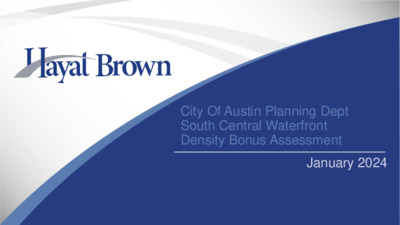18 Density Bonus Assessment.pdf — original pdf
Backup

City Of Austin Planning Dept South Central Waterfront Density Bonus Assessment January 2024 Contents Background Scope of Work I. II. III. Development Scenario Analysis 1 Background The City of Austin Planning Department is working to craft a density bonus program to encourage developers to provide community benefits in exchange for entitlement incentives within the South-Central Waterfront (“SCW”) planning area. The City sought third party review of the current Excel-based tool and underlying assumptions. Specifically, the City sought to understand: ▪ Are the methodology and mechanics of the SCW density bonus scenario tool functional and easy to use? ▪ Is this density bonus program sufficiently calibrated to motivate a developer to choose this program over a PUD process? 2 Stress Test Methodology ▪ Determine the value of incentive density granted through the density bonus program by netting the incremental project value for a participating project from one that completes a project under by-right zoning. ▪ Test two development options for the SCW District – small-scale and large- scale ▪ Compare project performance metrics between by-right and density bonus projects to test feasibility and relative value: ▪ Return on Cost ▪ Levered Internal Rate of Return ▪ Equity Multiple ▪ Capitalized Project Value 2. Stress Test Density Bonus Model Pro Forma Model Output BD Program Capitalized Market Value Total Development Costs BD Program Value Generated By-Right Capitalized Market Value Total Development Costs By-Right Capitalized Market Value BD Program Value Generated By-Right Capitalized Market Value Value of Incentive Density = = = - - - 3 2. Stress Test Density Bonus Model Development Scenarios Site Size GSF Multifamily (GSF) Small Scale Large Scale By-Right (CS-1-V-NP) Density Bonus Program By-Right (CS-1-V-NP) Density Bonus Program 1.5 Acres 4 Acres 191,233 127,100 524,825 348,150 509,872 338,850 1,373,957 910,300 (2 buildings) 30,000 Retail (GSF) 3,630 10,000 9,680 Parking (spaces)** 60,503 (173) 166,675 (476) 161,342 (461) 433,657 (1239) FAR 2.0* 8.0 2.0* 7.9 *Does not include parking area ** Above grade parking spots are 350 SF/Space 4 Bonus Fee in Lieu $5 (Residential) / $9 (Non-residential) / 5% On-site Affordable Housing 2. Stress Test Density Bonus Model Small Scale Development Large Scale Development ▪ By-right projects do not meet any of the 3 performance metric thresholds. ▪ Adding bonus density results in a marginally feasible project; returns drop with each public benefit (on-site affordable units / bonus fee) ▪ The inclusion of on-site affordable housing impacts project returns considerably, having a greater impact on long-term returns. ▪ Based on the spread between the return metrics and thresholds, the projects have limited capacity to fund public benefits and remain viable, given current market conditions. 5 ScenarioFeeAff. UnitsReturn on CostEquity MultipleLIRRBy Right5.4%1.368.4%Density Bonus✓✓5.9%1.6715.0%ThresholdCap Rate + 1%2.0015.0%ScenarioFeeAff. UnitsReturn on CostEquity MultipleLIRRBy Right5.3%1.337.8%Density Bonus✓✓5.9%1.6815.3%ThresholdCap Rate + 1%2.0015.0% Improved Economy Sensitivity Description ▪ Real estate markets across the country are struggling today, given high interest rates, construction costs, and operating costs. ▪ The Improved Economy Sensitivity analysis is intended to simulate an alternative, a more favorable real estate market, as the density bonus program should not be built only on a current economic snapshot in time. ▪ While the adjusted assumptions may not align directly with future economic conditions, they represent general reductions in costs and improved revenue generation typically seen in more favorable markets, but which could ultimately take many forms. 2. Stress Test Density Bonus Model Key Metrics Three key assumptions were altered in this sensitivity analysis: ▪ Capitalization rate decreased by 25bp to 4.75% 50bp to 5.0% ▪ Permanent interest rate is reduced by ▪ Operating costs grow at 2% annually (reduced from 3%) 6 Improved Economy Bonus Fee in Lieu-$5 (Residential)/$9 (Non-residential) / 5% On-site Affordable Housing 2. Stress Test Density Bonus Model Small Scale Development Large Scale Development By-right project does not meet any of the 3 performance metric thresholds. Adding bonus density results in a feasible project. ▪ ▪ ▪ Under improved market conditions the projects can fund public benefits and remain viable, at both $5/$9 fees and $12/$15 fees. ▪ The proposed fee structure ($5/$9/SF over 3:1 FAR) may be increased to provide additional public benefits without greatly impacting project viability and will likely endure changing market conditions. 7 ScenarioFeeAff. UnitsReturn on CostEquity MultipleLIRRBy Right5.3%1.4610.3%Density Bonus✓✓6.1%1.9319.6%ThresholdCap Rate + 1%2.0015.0%ScenarioFeeAff. UnitsReturn on CostEquity MultipleLIRRBy Right5.3%1.5011.2%Density Bonus✓✓6.0%1.9119.4%ThresholdCap Rate + 1%2.0015.0% Thank You